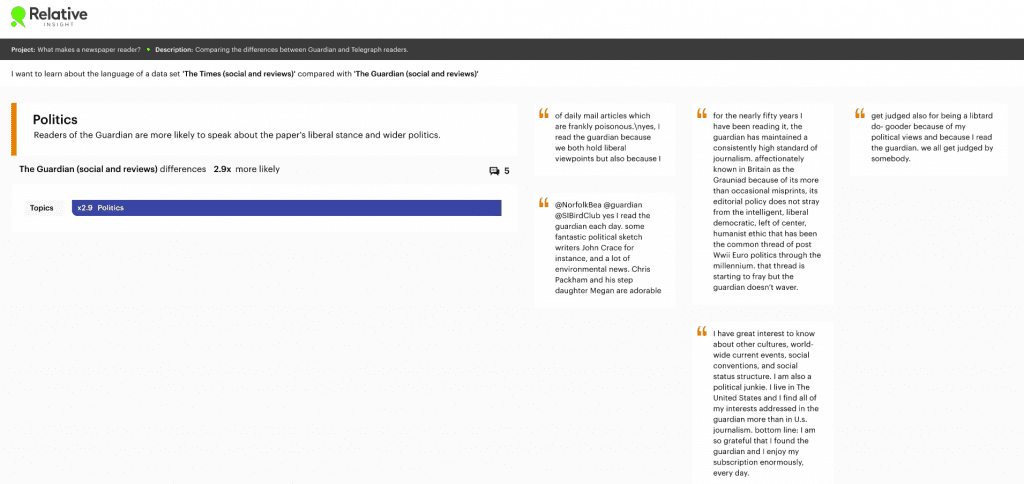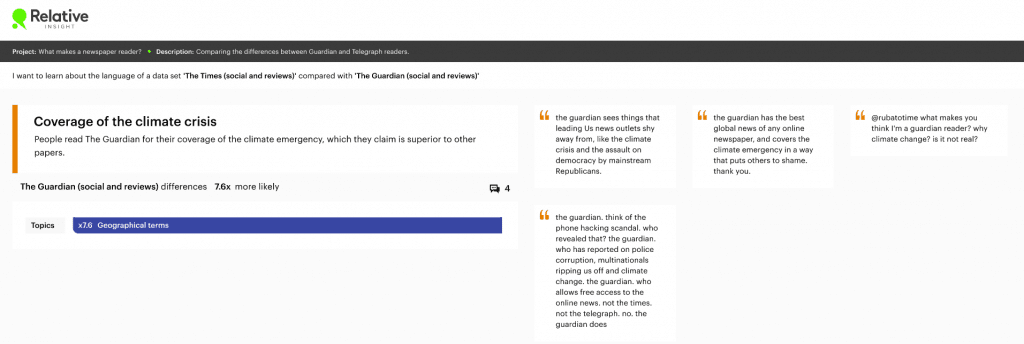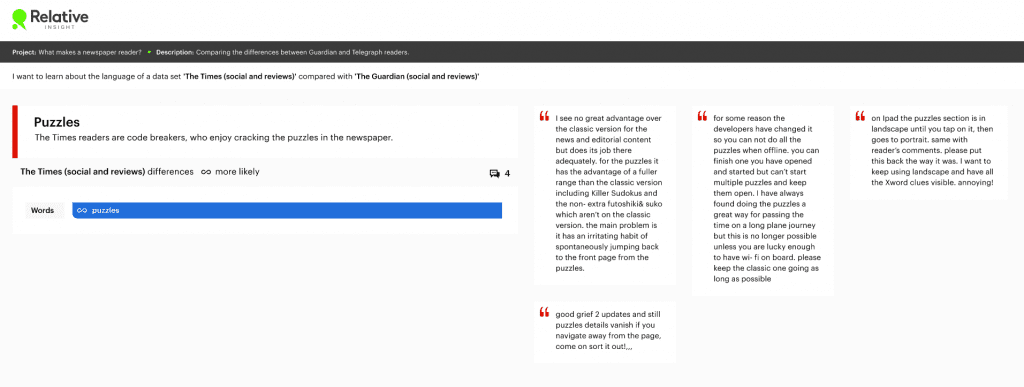Analyzing the differences between The Guardian readership and The Times

Newspaper stereotypes are age-old. Read The Guardian and you’re considered a liberal lefty. Read The Times you’re a businessman (or woman) with conservative views. But honestly, what’s with these readership generalizations?
Audience and insights professionals working for news publications are using Relative Insight to thoroughly analyze review data and enhance their social media analysis, in order to gain invaluable audience insights and understand the competitor landscape.
I wanted to investigate how two stalwart newspapers measure up against one another and discover what draws people to read specific publications. Comparing competitors allows us to see the strengths and weaknesses of a brand within the context of a larger industry.
To do this, I gathered app reviews of The Guardian and The Times, along with social mentions of each newspaper. I then uploaded this raw language data to Relative Insight text analytics platform and used the combined functionality to create two data sets to compare:
The Guardian readership vs The Times readership
Relative Insight’s text analytics technology compares two or more text data sets, revealing the unique words, phrases, topics and emotions in each. It’s crucial to know your competition in business. This example of competitor analysis reveals exactly who the target audience are for each newspaper, helping us to understand the pain points of each readership and what two competing giants can learn from one another…
The Guardian readership
Political
When looking at social mentions and reviews of The Guardian app, readers were 2.9x more likely to talk about the subject of politics. The Guardian has long been considered the leftist newspaper of the United Kingdom. Therefore, it’s no surprise that audiences chose to read this specific publication as it aligns with their “liberal viewpoints”. Furthermore, The Guardian readership claimed to enjoy the work of political sketch writers such as John Crace.


Climate conscious
Comparing The Guardian readership vs. The Times readership, revealed that Guardian readers were 7.6x more likely to use geographical terms across social mentions and reviews, including words like world, environment and climate. This insinuates that people are reading The Guardian for its coverage of the climate crisis and attention to environmental issues. One user claimed that The Guardian “covers the climate emergency in a way that puts others to shame” signifying that people feel the newspaper is superior because of this.


Global news
In the The Guardian readership vs. The Times readership comparison, Guardian readers were 5.5x more likely to use words such as international and worldwide in both their reviews and tweets. Readers clearly value the newspaper for its reporting on global stories and argue that it gives great insights into the American experience.


The Times readership
Code breakers
When looking at the other side of the The Guardian readership vs. The Times readership comparison, we found key insights into the readership of The Times. One is that Times readers were infinitely more likely to mention puzzles throughout their reviews and mentions, suggesting that they enjoy code-breaking and cracking crosswords in the paper.


Engagement
The analysis of The Guardian readership vs. The Times readership also revealed that Times readers were 8.3x more likely to talk about comments in their reviews and on social. This implies that this readership are more likely to engage with articles in The Times in comparison to The Guardian. Audiences enjoy reading through other people’s comments as well as having the opportunity to express their own opinions on different news stories.


The Guardian readership vs. The Times readership: Experiencing issues with the app
Due to analyzing app reviews as part of our comparison, we found that insights for The Times skewed more towards technical issues that digital readers were experiencing.
For instance, reviewers were 18.8x more likely to talk about app updates and complained about the new and latest version of The Times app. Readers expressed their frustrations with the app through words such as irritating and annoying.
Although this tells us less about what Times readers actually like about the newspaper, it’s still a valuable insight and highlights the importance of analyzing review data to uncover trends and customer pain points you might not have been aware of.
Comparing competitors by analyzing social and review data can give you surprising audience insights that you might not have known to look for. News publications can better understand who their audiences are, what their competitor’s audiences look like, how they can better appeal to readers and ultimately improve the reading experience.
